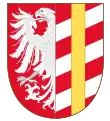Günzburg (district)
Günzburg is a Landkreis (district) in Swabia, Bavaria, Germany. It is bounded by (from the north and clockwise) the districts of Dillingen, Augsburg, Unterallgäu and Neu-Ulm, and by the state of Baden-Württemberg (districts Alb-Donau and Heidenheim).
Günzburg | |
|---|---|

| |
| Country | Germany |
| State | Bavaria |
| Adm. region | Swabia |
| Capital | Günzburg |
| Area | |
| • Total | 763 km2 (295 sq mi) |
| Population (31 December 2019)[1] | |
| • Total | 127,027 |
| • Density | 170/km2 (430/sq mi) |
| Time zone | UTC+01:00 (CET) |
| • Summer (DST) | UTC+02:00 (CEST) |
| Vehicle registration | GZ |
| Website | landkreis-guenzburg.de |
For the capital, see Günzburg.
History
In the early Middle Ages the tiny county of Burgau ruled the region. In 1213 the county was acquired by the lords of Berg; it was then known as Berg-Burgau, but the last ruler of this collateral line died in 1301, and Burgau (now raised to the level of a margraviate) became an exclave of Austria. In the early 17th century the administrative seat was moved from the town of Burgau to Günzburg, but the margraviate retained its name. When the Holy Roman Empire ceased to exist in 1806, the margraviate was dissolved and the region was annexed by Bavaria.
The district was established in 1972 by merging the former districts of Günzburg and Krumbach. Günzburg lost its status as an urban district and became the administrative seat of the new district.
Geography
The Danube river and its tributaries characterise this district. The Danube runs through the northernmost parts of the district, passing the cities of Günzburg and Leipheim. There are several affluents coming from the south, for example Biber, Günz and Mindel. Most of the district's area is covered with forests; the eastern third of the territory is part of the Augsburg Western Forests Nature Park.
Coat of arms
 |
On the right there are the old arms of the margravate of Burgau: red and white with a yellow beam. The eagle is from the arms of the Schwabegg-Ursberg family, which founded two monasteries in the district. |
Towns and municipalities

| Towns | Municipalities | |
|---|---|---|
References
- "Tabellenblatt "Daten 2", Statistischer Bericht A1200C 202041 Einwohnerzahlen der Gemeinden, Kreise und Regierungsbezirke". Bayerisches Landesamt für Statistik und Datenverarbeitung (in German). July 2020.
External links
| Wikimedia Commons has media related to Landkreis Günzburg. |
- (in German) Official website